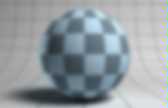

Nutty Software. SkyGen is a WebGL tool that lets you create skyboxes for your games.

The tool uses an approximate atmospheric scattering algorithm to render a realistic atmosphere in real-time. The tool also lets you add and configure simple clouds in your sky. Once you’re satisfied with your result, you can export the images to a separate browser window where you can save each file individually and use them in your skybox. You can also export a single image that will show you a panoramic view of your sky. This tool uses GLSL noise code from Ashima Arts. This WebGL demo simulates 1,000,000 particles swimming around in the screen. Dare for a scare? This HTML 5 demo uses the drawing features of the HTML 5 Canvas. Daniel Burke's blog: One Shiny Dragon + Source. This is viewing a hollow shell of the XYZ RGB Asian Dragon at 1024^3, using what I've written so far of my attempt to implement Cyril Crassin'sGigaVoxel method.
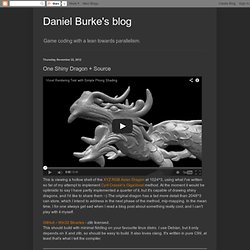
At the moment it would be optimistic to say I have partly implemented a quarter of it, but it's capable of drawing shiny dragons, and I'd like to share them :-) The original dragon has a tad more detail than 2048^3 can store, which I intend to address in the next phase of the method, mip-mapping. In the mean time, I for one always get sad when I read a blog post about something really cool, and I can't play with it myself. GitHub - Win32 Binaries - zlib licensed. This should build with minimal fiddling on your favourite linux distro. I use Debian, but it only depends on X and zlib, so should be easy to build. Going Deeper... To all yee who explore the source code, fair warning, it's a hatchet job. Convert and polyview convertoct and octview The Data A 1024^3 cube is big. The Build System & Porting voxel.c render.frag.
RIGID GEMS Website. Random space filling tiling of the plane. Written by Paul Bourke July 2011 Initial concept and inspiration by John Shier.
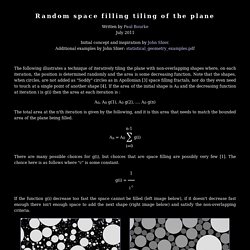
Additional examples by John Shier: statistical_geometry_examples.pdf The following illustrates a technique of iteratively tiling the plane with non-overlapping shapes where, on each iteration, the position is determined randomly and the area is some decreasing function. Note that the shapes, when circles, are not added as "Soddy" circles as in Apollonian [3] space filling fractals, nor do they even need to touch at a single point of another shape [4].
If the area of the initial shape is A0 and the decreasing function at iteration i is g(i) then the area at each iteration is : A0, A0 g(1), A0 g(2), .... The total area at the n'th iteration is given by the following, and it is this area that needs to match the bounded area of the plane being filled. There are many possible choices for g(i), but choices that are space filling are possibly very few [1]. Hartverdrahtet (Akronyme Analogiker) Moleman 2: Demoscene - The Art Of The Algorithms. Although existing art media have been transformed in the digital age, the advent of computers has brought new art forms into being.
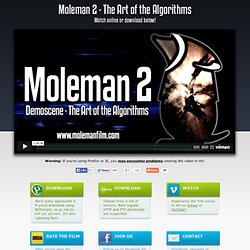
In the past, visual arts and music required both intellectual and physical skills, but in the present, computer programming permits people to make art just by using their minds. Moleman 2 presents a subculture of digital artists working with both new and old computing technology who push their machines to their limits. The demoscene is a computer art subculture centered around demos, which are generally non-interactive audiovisual presentations that run realtime on computers and demonstrate programming, artistic, and musical skills. The demoscene first appeared during the 8-bit era on computers such as the Commodore 64, ZX Spectrum, and Amstrad CPC, and came to prominence during the rise of 16 and 32-bit systems, such as the Atari ST and Amiga. Initially, demos had a strong connection with software cracking.
Showcase: Amazing One-Texture Environment - Epic UDK. What is UDK?
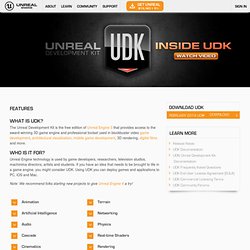
The Unreal Development Kit is the free edition of Unreal Engine 3 that provides access to the award-winning 3D game engine and professional toolset used in blockbuster video game development, architectural visualization, mobile game development, 3D rendering, digital films and more. Who is it for? Unreal Engine technology is used by game developers, researchers, television studios, machinima directors, artists and students.
If you have an idea that needs to be brought to life in a game engine, you might consider UDK. Using UDK you can deploy games and applications to PC, iOS and Mac. Note: We recommend folks starting new projects to give Unreal Engine 4 a try!